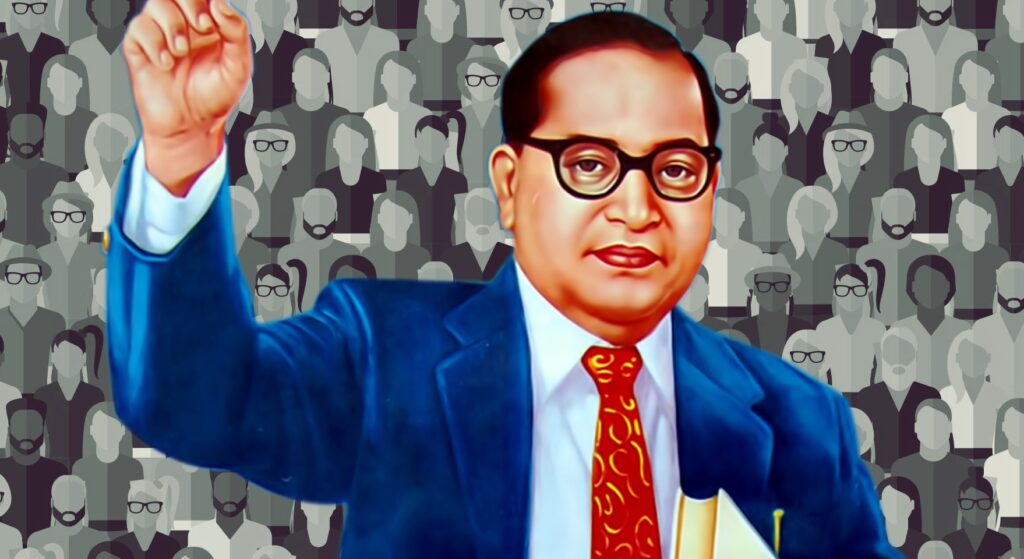Biography
ISC# 14041891

Early life
Ambedkar was born on 14 April 1891 in the town and military cantonment of Mhow (now officially known as Dr Ambedkar Nagar) in the Central Provinces (now in Madhya Pradesh).He was the 14th and last child of Ramji Maloji Sakpal, an army officer who held the rank of Subedar, and Bhimabai Sakpal, daughter of Laxman Murbadkar.His family was of Marathi background from the town of Ambadawe (Mandangad taluka) in Ratnagiri district of modern-day Maharashtra. Ambedkar was born into a Mahar (dalit) caste, who were treated as untouchables and subjected to socio-economic discrimination. Ambedkar’s ancestors had long worked for the army of the British East India Company, and his father served in the British Indian Army at the Mhow cantonment. Although they attended school, Ambedkar and other untouchable children were segregated and given little attention or help by teachers. They were not allowed to sit inside the class. When they needed to drink water, someone from a higher caste had to pour that water from a height as they were not allowed to touch either the water or the vessel that contained it. This task was usually performed for the young Ambedkar by the school peon, and if the peon was not available then he had to go without water; he described the situation later in his writings as “No peon, No Water”.[19] He was required to sit on a gunny sack which he had to take home with him.
Ramji Sakpal retired in 1894 and the family moved to Satara two years later. Shortly after their move, Ambedkar’s mother died. The children were cared for by their paternal aunt and lived in difficult circumstances. Three sons – Balaram, Anandrao and Bhimrao – and two daughters – Manjula and Tulasa – of the Ambedkars survived them. Of his brothers and sisters, only Ambedkar passed his examinations and went to high school. His original surname was Sakpal but his father registered his name as Ambadawekar in school, meaning he comes from his native village ‘Ambadawe’ in Ratnagiri district. His Devrukhe Brahmin teacher, Krishnaji Keshav Ambedkar, changed his surname from ‘Ambadawekar’ to his own surname ‘Ambedkar’ in school records.
Education
Post-secondary education
In 1897, Ambedkar’s family moved to Mumbai where Ambedkar became the only untouchable enrolled at Elphinstone High School. In 1906, when he was about 15 years old, he married a nine-year-old girl, Ramabai. The match per the customs prevailing at that time was arranged by the couple’s parents.
Studies at the University of Bombay
In 1907, he passed his matriculation examination and in the following year he entered Elphinstone College, which was affiliated to the University of Bombay, becoming, according to him, the first from his Mahar caste to do so. When he passed his English fourth standard examinations, the people of his community wanted to celebrate because they considered that he had reached “great heights” which he says was “hardly an occasion compared to the state of education in other communities”. A public ceremony was evoked, to celebrate his success, by the community, and it was at this occasion that he was presented with a biography of the Buddha by Dada Keluskar, the author and a family friend.
By 1912, he obtained his degree in economics and political science from Bombay University, and prepared to take up employment with the Baroda state government. His wife had just moved his young family and started work when he had to quickly return to Mumbai to see his ailing father, who died on 2 February 1913.[32]
Studies at Columbia University
In 1913, at the age of 22, Ambedkar moved to the United States. He had been awarded a Baroda State Scholarship of £11.50 (Sterling) per month for three years under a scheme established by Sayajirao Gaekwad III (Gaekwad of Baroda) that was designed to provide opportunities for postgraduate education at Columbia University in New York City. Soon after arriving there he settled in rooms at Livingston Hall with Naval Bhathena, a Parsi who was to be a lifelong friend. He passed his M.A. exam in June 1915, majoring in Economics, and other subjects of Sociology, History, Philosophy and Anthropology. He presented a thesis, Ancient Indian Commerce. Ambedkar was influenced by John Dewey and his work on democracy.
In 1916 he completed his second thesis, National Dividend of India – A Historic and Analytical Study, for another M.A.[34] On 9 May, he presented the paper Castes in India: Their Mechanism, Genesis and Development before a seminar conducted by the anthropologist Alexander Goldenweiser.
Studies at the London School of Economics
Ambedkar (In center line, first from right) with his professors and friends from the London School of Economics (1916–17)
In October 1916, he enrolled for the Bar course at Gray’s Inn, and at the same time enrolled at the London School of Economics where he started working on a doctoral thesis. In June 1917, he returned to India because his scholarship from Baroda ended. His book collection was dispatched on a different ship from the one he was on, and that ship was torpedoed and sunk by a German submarine. He got permission to return to London to submit his thesis within four years. He returned at the first opportunity, and completed a master’s degree in 1921. His thesis was on “The problem of the rupee: Its origin and its solution”. In 1923, he completed a D.Sc. in Economics which was awarded from University of London, and the same year he was called to the Bar by Gray’s Inn. His third and fourth Doctorates (LL.D, Columbia, 1952 and D.Litt., Osmania, 1953) were conferred honoris causa.
Opposition to untouchability
Ambedkar as a barrister in 1922
As Ambedkar was educated by the Princely State of Baroda, he was bound to serve it. He was appointed Military Secretary to the Gaikwad but had to quit in a short time. He described the incident in his autobiography, Waiting for a Visa.Thereafter, he tried to find ways to make a living for his growing family. He worked as a private tutor, as an accountant, and established an investment consulting business, but it failed when his clients learned that he was an untouchable. In 1918, he became Professor of Political Economy in the Sydenham College of Commerce and Economics in Mumbai. Although he was successful with the students, other professors objected to his sharing a drinking-water jug with them.
Ambedkar had been invited to testify before the Southborough Committee, which was preparing the Government of India Act 1919. At this hearing, Ambedkar argued for creating separate electorates and reservations for untouchables and other religious communities. In 1920, he began the publication of the weekly Mooknayak (Leader of the Silent) in Mumbai with the help of Shahu of Kolhapur i.e. Shahu IV (1874–1922).
Ambedkar went on to work as a legal professional. In 1926, he successfully defended three non-Brahmin leaders who had accused the Brahmin community of ruining India and were then subsequently sued for libel. Dhananjay Keer notes that “The victory was resounding, both socially and individually, for the clients and the doctor”.
While practising law in the Bombay High Court, he tried to promote education to untouchables and uplift them. His first organised attempt was his establishment of the central institution Bahishkrit Hitakarini Sabha, intended to promote education and socio-economic improvement, as well as the welfare of “outcastes”, at the time referred to as depressed classes. For the defence of Dalit rights, he started many periodicals like Mook Nayak, Bahishkrit Bharat, and Equality Janta.
He was appointed to the Bombay Presidency Committee to work with the all-European Simon Commission in 1925. This commission had sparked great protests across India, and while its report was ignored by most Indians, Ambedkar himself wrote a separate set of recommendations for the future Constitution of India.
By 1927, Ambedkar had decided to launch active movements against untouchability. He began with public movements and marches to open up public drinking water resources. He also began a struggle for the right to enter Hindu temples. He led a satyagraha in Mahad to fight for the right of the untouchable community to draw water from the main water tank of the town. In a conference in late 1927, Ambedkar publicly condemned the classic Hindu text, the Manusmriti (Laws of Manu), for ideologically justifying caste discrimination and “untouchability”, and he ceremonially burned copies of the ancient text. On 25 December 1927, he led thousands of followers to burn copies of Manusmriti. Thus annually 25 December is celebrated as Manusmriti Dahan Din (Manusmriti Burning Day) by Ambedkarites and Dalits.
In 1930, Ambedkar launched the Kalaram Temple movement after three months of preparation. About 15,000 volunteers assembled at Kalaram Temple satygraha making one of the greatest processions of Nashik. The procession was headed by a military band and a batch of scouts; women and men walked with discipline, order and determination to see the god for the first time. When they reached the gates, the gates were closed by Brahmin authorities.
Poona Pact
M.R. Jayakar, Tej Bahadur Sapru and Ambedkar at Yerwada jail, in Poona, on 24 September 1932, the day the Poona Pact was signed
In 1932, the British colonial government announced the formation of a separate electorate for “Depressed Classes” in the Communal Award. Gandhi fiercely opposed a separate electorate for untouchables, saying he feared that such an arrangement would divide the Hindu community. Gandhi protested by fasting while imprisoned in the Yerwada Central Jail of Poona. Following the fast, congressional politicians and activists such as Madan Mohan Malaviya and Palwankar Baloo organised joint meetings with Ambedkar and his supporters at Yerwada.On 25 September 1932, the agreement, known as the Poona Pact was signed between Ambedkar (on behalf of the depressed classes among Hindus) and Madan Mohan Malaviya (on behalf of the other Hindus). The agreement gave reserved seats for the depressed classes in the Provisional legislatures within the general electorate. Due to the pact the depressed class received 148 seats in the legislature instead of the 71, as allocated in the Communal Award proposed earlier by the colonial government under Prime Minister Ramsay MacDonald. The text used the term “Depressed Classes” to denote Untouchables among Hindus who were later called Scheduled Castes and Scheduled Tribes under the India Act 1935, and the later Indian Constitution of 1950. In the Poona Pact, a unified electorate was in principle formed, but primary and secondary elections allowed Untouchables in practice to choose their own candidates.
